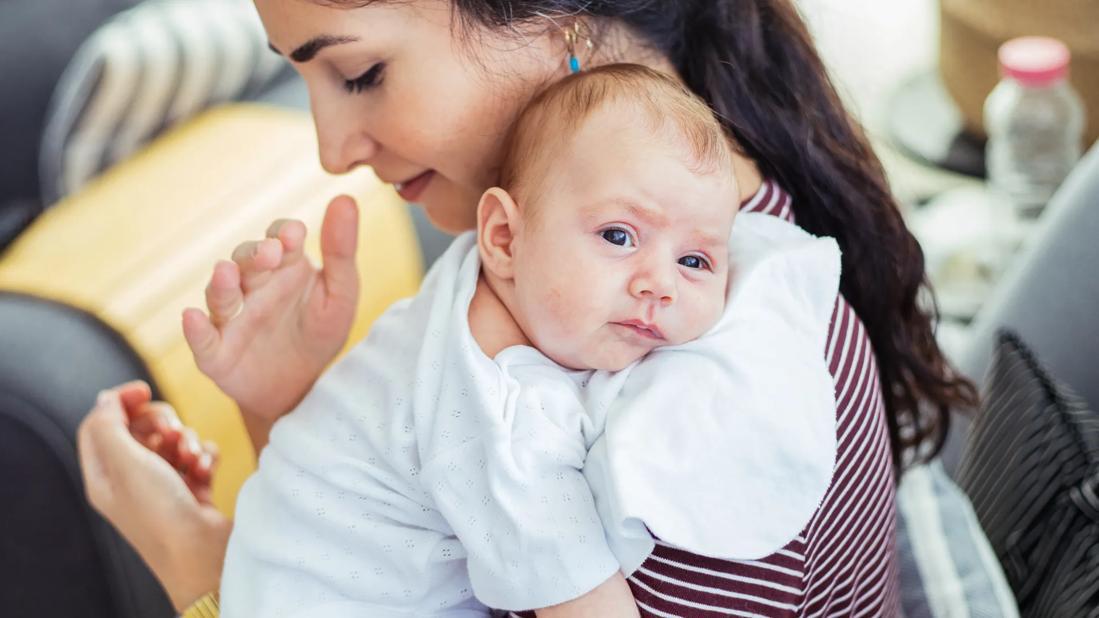Burping Your Baby: Techniques, Tips and Timing
Try to burp your baby mid-feed and after they finish eating — but don’t sweat it if they don’t burp

Babies are just the cutest, aren’t they? Everything from their sweet little toes to their adorable little snores can be a thing of beauty. And those baby burps? Surprisingly satisfying — both for you and them.
But sometimes, they need a hand getting a good burp out. How do you know when they need you? And what’s the best burping position?
Pediatrician Amy Sniderman, MD, shares advice for how to burp your baby.
Burping techniques and tips
There’s no “right” way to burp a baby. But some techniques can be more effective than others.
Consider these best practices and useful tips:
- Pat in the right place. Aim for their mid-to-low back — not between the shoulder blades. “You want to pat at the level of their belly to get the gas out,” Dr. Sniderman advises.
- Have a burp cloth at the ready. Spit happens — and some babies spit up a lot. Keep a rag or burp cloth handy to catch the goo. “Almost all babies spit up at some point. But as long as they’re gaining weight, it’s likely very normal,” she reassures.
- Support their head. Even babies with decent head control can turn into bobbleheads when you’re patting and rubbing their backs. Give them a hand to keep their head steady.
Here are three burp positions to try:
Seated burping
For little babies who can’t yet hold their heads up on their own, this seated burping position allows you to help with head support.
- Sit on a chair or couch.
- Sit your baby on your lap, facing the side.
- Lean baby forward slightly, supporting their chest with one palm. Cup your index finger and thumb around their jaw to keep their head supported. Make sure not to press on their throat.
- Use your other hand to gently pat or rub their mid-to-low back.
Over-the-shoulder pat
This position uses your shoulder to add a bit of pressure to your baby’s belly to help them burp.
- Hold your baby upright with their chin peeking over your shoulder.
- Use one arm to support their bum and keep them in position.
- Use your other hand to gently pat or rub their mid-to-lower back.
If your baby hasn’t yet mastered head control, you can adjust this position to help support their noggin. Hold them with their head turned to one side and resting against your chest.
Lap laying
Perhaps less common but potentially effective, you can burp your baby lying down on your lap.
- Sit on a chair or couch with your feet flat on the floor.
- Lie your baby across your lap, on their belly. Their head should be turned to one side with that cheek fully supported by your leg.
- Position your legs so their upper body is slightly inclined. You might do this by raising one of your heels.
- Gently pat or rub their mid-to-lower back.
“The idea is that their belly should be in contact with your leg to put pressure on their belly and get the gas moving,” Dr. Sniderman explains.
When to burp your baby
Most babies benefit from being burped from their first days in the world through about the 9-month mark. Needing an occasional burp up through their first birthday is still quite normal, too.
Dr. Sniderman recommends burping a baby at least two times per feeding:
- Halfway through a bottle, or when they switch sides during a nursing session.
- At the end of the feeding.
“Babies can swallow air when they’re drinking. Air means gas, and gas can make babies uncomfortable and cranky,” Dr. Sniderman notes. “They’re not as good at clearing gas themselves, so it’s normal that they might need a little assistance.”
A baby who’s ready for a burp might show signs like:
- Fussiness or restlessness
- Crying
- Kicking their legs
- Squirming
“If you lie your baby down after a feed and they start crying pretty quickly, it might be a sign that they need to burp again,” she adds.
How long to burp a baby
Not all babies are going to burp at every feeding every time. So, if it’s not happening, move along.
“I recommend burping your baby for just a minute or two max,” Dr. Sniderman says. “If they burp right away, great. But if they haven’t burped after about two minutes, they’re probably not going to.”
The longer you spend trying to burp them, the more opportunities can arise for frustration on both sides.
Think about it: If your baby is mid-feed and you stop to burp them, they probably won’t love the interruption, especially if they aren’t feeling gassy. And the longer you wait to get back to mealtime, the more annoyed they may get.
What are they going to do? They’re going to beg you to bring back the food. They might cry and fuss and whine. And what happens when babies cry? They swallow more air ... and they get gassy.
So, even if they didn’t need to burp to begin with, now they do. And they’re hangry to boot.
Bottom line
Burping your baby is up there with changing, feeding and bathing them. It’s all part of keeping them healthy and happy.
If you’re concerned that gas is making your baby uncomfortable, or if they’re not gaining weight, talk with their pediatrician. And while spitting up is often OK, get in touch with a doctor right away if your baby:
- Is extremely fussy
- Has a large volume of spit-up
- Has spit-up that is bloody, black, bright yellow or bright green
- Has projectile spit up
They can check for reasons for spit-up and gassiness and offer tips for relief.